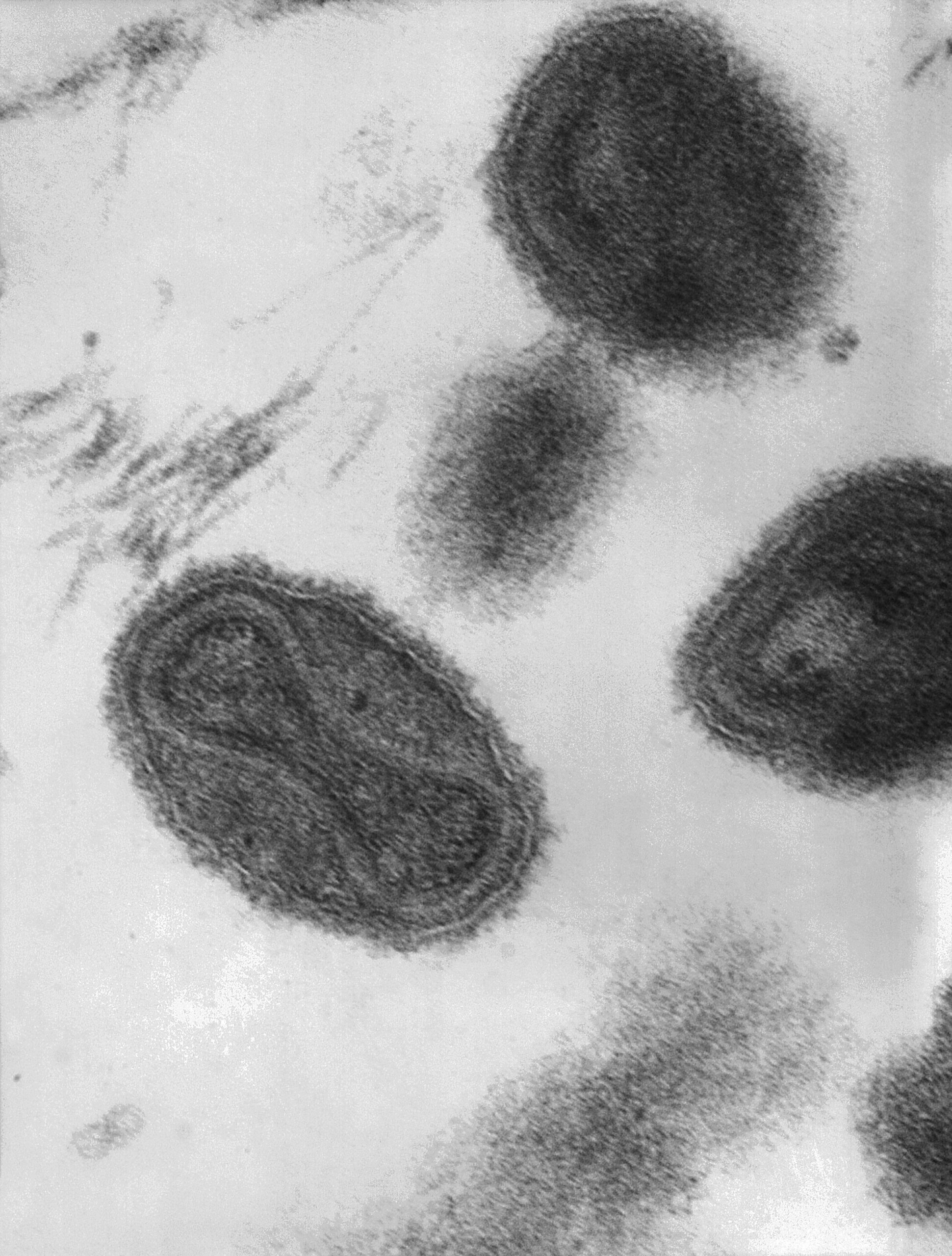Playlist
Show Playlist
Hide Playlist
Poxviruses
00:01 Poxviridae, viruses. 00:04 The poxviruses are large, brick-shaped, enveloped -- in fact, they're the largest DNA double-stranded viruses that we know of. 00:13 And you can see a scanning electron microscope picture on the right. 00:17 It's a very prominent, bulky virus itself. 00:21 Its genome double-stranded DNA is also linear in nature. 00:26 The virus is unusual because it carries a mechanism to create its own RNA polymerase. 00:33 And this is important, if you remember back to normal viral growth, in that it can replicate in the cytoplasm. 00:41 It does not have to borrow its host cell's RNA polymerase. 00:45 Therefore, it can virally replicate even more prominently, which again is good because it's so big. 00:54 Only, again, when it lyses its host cell does one get the cytolytic infections, the immune response. 01:01 There are several different important poxviruses that we need to consider. 01:06 The first, and perhaps the most prominent, are the orthopoxviruses. 01:11 And you can see on the slide, the specific species variola virus, vaccinia virus, cowpox virus, and even monkeypox virus. 01:20 So, as we'll see, these are associated with smallpox or smallpox-looking infections The parapox virus, are orf virus, pseudocowpox virus, and bovine popular stomatitis virus. 01:35 Rarely do we encounter these in clinical medicine, although there have been some reports of orf virus surfacing, especially coming from countries in Africa. 01:45 The yatapox viruses are tanapox virus and Yaba monkey tumor virus limited primarily to the animal kingdom and not things that are not viruses, which we typically see in clinical medicine. 01:58 But we do see the molluscipoxvirus, or the Molluscum contagiosum virus, MCV, and what we'll talk a little bit more about that at the end of this presentation. 02:09 So, let's start with the most prominent ones, the ones which occupy everybody's view and vision, both historically and in terms of current bioterrorist attack. 02:18 And these are the variola, vaccinia, and cowpox viruses. 02:22 The variola virus, the cause of smallpox, is historically of incredible significance. 02:28 There are some fabulous literature written about the journey to discover and then eradicate the smallpox. 02:35 And eradication was successful in 1980, with the potential exception of several of the larger countries in the world holding on to repositories of virus, just in case. 02:47 So unfortunately, fears of weaponized smallpox still exists and occasional attempts to vaccinate first responders have been conducted, actually, in the recent future. 03:00 The cowpox virus was renowned for causing similar pox-looking pustules, but in dairymaids, the ones who are milking the cows. 03:10 And in fact, it was those lesions which were harvested by Dr. Jenner to create the first vaccine against smallpox. 03:19 Now, it was dirty. 03:20 It was messy, but it was actually relatively successful, and one of the first examples of successful vaccination strategies which we know about in medical history. 03:30 The smallpox vaccine is able to use live, but attenuated, meaning process to remove any virulence. 03:39 Vaccinia virus, and this vaccine, as I mentioned, has been re-initiated, somewhat recently, for military or personnel or healthcare personnel, first responders, because of the concern for bioterrorism. 03:53 The images which you see on this slide, the lower right represents the site of primary vaccination with vaccinia virus. 04:01 Yeah, it's ugly, it's messy, and it weeps active vaccinia virus for at least several weeks, hence, it's typically covered by, in this case, a band aid. 04:12 The image on the upper right shows extensive lesions, not just smallpox, but of a vaccinia reaction. 04:19 That is a patient who, for whatever reason, developed viremia related to the vaccination, and developed the equivalent of a smallpox, but carried out by vaccinia. 04:29 And such vaccine reactions occurred in a cluster of cases after the vaccine strategies occurred recently in the States.
About the Lecture
The lecture Poxviruses by Sean Elliott, MD is from the course Viruses.
Included Quiz Questions
The enzyme that gives poxviruses the ability to replicate in the cytoplasm is...?
- ...RNA polymerase.
- ...reverse transcriptase.
- ...RNA hydroxylase.
- ...DNA hydroxylase.
- ...DNA reductase.
Cowpox viral species belongs to which of the following genera of poxviruses?
- Orthopoxvirus
- Parapoxvirus
- Yatapoxvirus
- Molluscipoxvirus
- Capripoxvirus
Which of the following viruses in the live attenuated form are used to vaccinate individuals at risk of developing smallpox?
- Vaccinia virus
- Variola virus
- Monkeypox virus
- Tanapox virus
- Pseudocowpox virus
Customer reviews
5,0 of 5 stars
| 5 Stars |
|
5 |
| 4 Stars |
|
0 |
| 3 Stars |
|
0 |
| 2 Stars |
|
0 |
| 1 Star |
|
0 |




